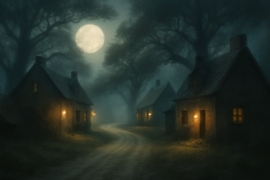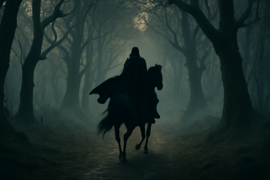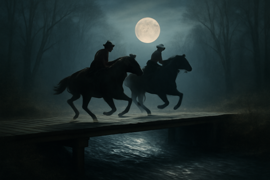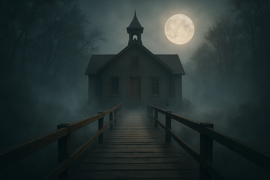Introduction
Past the winding Hudson River, hidden in a pocket of New York State, lies Sleepy Hollow—a place where moonlight filters through ancient sycamores, and fog clings to every silent path. In autumn’s twilight, the air itself feels haunted, as if carrying echoes of centuries-old whispers. When Ichabod Crane, a lanky schoolmaster with more faith in book learning than in folk tales, arrives to teach the village children, he hopes for a quiet life. Instead he finds himself welcomed by suspicious glances and hushed warnings of a terrible specter: the Headless Horseman, said to gallop through the darkness, searching for a lost head beneath a starless sky. Though Ichabod dismisses such stories as superstition, he cannot escape the uneasy tug of Sleepy Hollow’s own peculiar magic. Each evening, the schoolhouse windows glow with lantern light and every rustle outside threatens to reveal a phantom rider poised to pounce. As he settles into his new home—a small ramshackle cottage at the edge of town—he notices abandoned trinkets and iron horseshoes placed on doorsteps, charms meant to ward off evil. Though fascinated, he cannot decide if these are practical talismans or the desperate acts of fearful hearts. Yet the restless hush, the distant hooting of owls, and the sudden hush of crickets warn him that in Sleepy Hollow, no mind, however rational, can remain free of dread.
The New Schoolmaster Arrives
Ichabod Crane carried with him a battered satchel of chalk and parchment, a few well-worn suits, and an abiding faith in scholarship. At first glance, he seemed ill-suited to Sleepy Hollow’s eerie temperament—his long frame went stiff at a sudden breeze, and he consulted his charts for constellations whenever night fell. Yet the townsfolk, eager for any teacher who could impart geometry and geography, welcomed him with cautious courtesy.

Under lantern light, Ichabod crisscrossed the narrow streets, nodding to shuttered cottages and inhaling the scent of wood smoke. He noted crumbling fenceposts and carved horse-head emblems tacked to barn walls, symbols intended to placate a restless spirit. One evening at supper, Mrs. Van Tassel, the proprietor of his modest lodgings, recounted in hushed tones the tale of a Hessian soldier whose head was lost beneath the Ice Bridge during the Revolutionary War. The Headless Horseman, she declared, prowled the hollow to reclaim what was stolen. Ichabod laughed politely, but his heart pounded as thunder rolled overhead.
Night after night, he emerged from his candlelit studies to find a lone lantern swinging at his door, placed there by an anonymous helper—or perhaps a warning. Curiosity warred with prudence as he debated whether those who set the lantern were kind souls or conspirators in a long-held prank. One moonlit walk through the grove convinced him that wisdom alone could not silence the voices that seemed to drift among the oaks. He resolved to learn more, consulting old manuscripts and gathering local legends, determined to understand the gravity that bound the headless rider to his forsaken hollow.
Whispers of the Headless Rider
Rumors swirled in Sleepy Hollow like restless spirits. By day, farmers spoke of horse hooves heard but never seen, clattering on the riverbank’s wooden planks. Children told of a lantern bobbing through the mist, as if carried by a rider missing both face and flesh. Yet few had faced the apparition directly—those who claimed they did returned pale, haunted, and forever changed.

Ichabod listened to every fragment of gossip, cherishing the chance to assemble facts into a coherent narrative. In the dusty back room of Old Baltus Van Tassel’s farmhouse, he discovered tattered letters describing the Hessian’s doomed midnight assault, and how villagers once chased the phantom across fields lit only by stars. The tale spoke of a headless figure, heavy cloak flying, brandishing a jagged steel blade where his throat should have been. Each scribble in that brittle journal sent a new tremor through his scholarly resolve.
Despite his keen mind, Ichabod found himself restless as twilight descended. The air grew damp, and the trees whispered warnings. One night he strolled too close to the old churchyard, where cracked gravestones jutted from the earth like broken teeth. He felt a presence behind him and turned—only to see a lantern’s pale glow bobbing among silhouettes. His rational self urged him to retreat, yet morbid fascination held him rooted. Was this a prank, or had he stumbled upon the legendary rider himself? As the lantern drew nearer, the outline of a horse’s neck emerged, muscles rippling beneath the faint light.
A sudden gust snuffed out the lantern, plunging him into darkness. He heard a distant neigh, like steel ringing on stone, and felt cold fear snake through him. In that moment he understood: Sleepy Hollow’s legend was neither idle tale nor cheap fright; it was a force older than memory, and tonight, it stirred anew.
The Midnight Chase
As the moon climbed high, Ichabod’s heart pounded like distant drums. He mounted his borrowed steed—an old plowhorse more accustomed to fields than flight—and raced down the hollow’s twisting roads. Behind him, he heard the thunderous gallop of hooves that seemed too powerful for any earthly horse. Every tree blurred past him, each branch a skeletal hand reaching for his cloak.

On the outskirts of town stood an old wooden bridge, its planks rotting and misaligned. Ichabod spurred his mount, praying to reach solid ground. Yet the headless rider closed fast, his steel blade catching moonlight as he swung it in a glance that felt like thunder. The air smelled of damp earth and cold iron. Ichabod heard a hollow rattle where a head should be, and glimpsed the empty collar through which rain dripped in cold droplets.
In a desperate bid, Ichabod leaned forward, urging the plowhorse onto the narrow bridge. The boards cracked beneath their weight, groaning as if warning them back. Only the faint glimmer of the town’s lanterns awaited beyond. He prayed for the cloak of courage to settle over him, though every instinct screamed to flee deeper into the woods.
Just as the bridge’s center approached, thunder roared and a brilliant flash of lightning illuminated the hollow in silver-white. Ichabod glanced back to see the rider raise his blade and hurl it toward him—a gleaming jack-o’-lantern head arcing through the air. With a single bound, Ichabod flung himself free and tumbled into the bushes, lantern shattering at his feet.
When dawn broke, the townsfolk found only Ichabod’s hat, torn and bloodied, and the shattered lantern on the far side of the creek. His horse was gone, and the bridge lay silent once more. Whether he was spirited away by the rider or vanished into superstition, none could say. Yet his story joined the hollow’s endless whispers, another chapter in the legend of the Headless Horseman.
Conclusion
No record ever explained Ichabod Crane’s final fate. Some say he left town, too shaken to stay; others whisper the Headless Horseman claimed his soul beneath a moonless sky. In Sleepy Hollow today, travelers still find horseshoes nailed above doorways and lanterns left burning on lonely paths. They say the phantom rider’s hooves echo in the wind, a warning that certain legends never die. Whether a ghost, a prankster in disguise, or a memory older than the village itself, the Headless Horseman endures—an eternal witness to the thin boundary between superstition and reality. And each autumn night, when the fog creeps low and the oaks stand still, you might feel the hush of unseen riders passing by, reminding every heart that some stories demand their ending remain unknown.

















